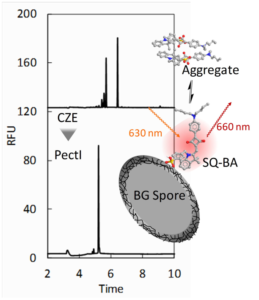Spatial separation of substances is a basic and important chemical technique. Furthermore, detecting the separated substances with ultra-high sensitivity will allow excellent analytical methods without interference. Electrophoresis is a candidate for such an analytical method, comparable with chromatography. Our strategy to develop novel analytical method is to sophisticatedly integrate chemical reactions (thermodynamic, spectroscopic, and kinetic properties) into electrophoresis to exert superb functions. We have combined unique chemical reactions with capillary (CE) or slab gel electrophoresis to develop simple and highly sensitive and selective analytical methods. Some examples are given below.

To date, it is well known that it is difficult to form emissive heavy metal complexes with organic ligands to be fluorescently detected, since they frequently quench the fluorescence originated from emissive ligands through paramagnetic quenching and heavy atom effects. We developed a series of efficiently fluorescent ligand (probe) that is not quenched even when complexed with heavy metal ions. Separating those metal-probe complexes by CE, ultrasensitive detection of heavy metal ions at ppt levels (pM) was successfully achieved. In addition, to control electric charge of the metal-probe complexes via dynamic ternary complex equilibria and to control molecular shape recognition by cationic polymer were introduced into a separation field, allowing the rapid isolation of lanthanide (Ln) ions. Furthermore, probes specific towards actinide (An) ions have been successfully developed. We aim to develop a method of measuring An and Ln ions in radiation-tainted water and spent nuclear fuel, which have recently caused social problems in Japan. We are collaborating on this research project with a research group in France and the Japan Atomic Energy Agency.
Reference: S. Saito et al., Journal of Chromatography A, 1232, 152-157 (2012). S. Saito et al., Analyst, 136, 2697-2705 (2011).
 Microbial cells, as well as molecules, can be separated by CE. So far, many researchers reported CE for microorganisms. However, they had serious problems with reproducibility, such as split peak and large shift in detection time. We simultaneously employed on-capillary concentration technique, called capillary transient isotachophoresis (ctITP), and addition of a water-soluble polymer into an electrolyte solution to focus cells, resulting in a highly-reproducible CE technology, in which a single peak of microbe cells is obtained. This polymer-enhanced capillary transient isotachophoresis (PectI) allows highly-sensitive bacterial separation and detection. We are collaborating on this project with research groups in the United States and Netherlands.
Microbial cells, as well as molecules, can be separated by CE. So far, many researchers reported CE for microorganisms. However, they had serious problems with reproducibility, such as split peak and large shift in detection time. We simultaneously employed on-capillary concentration technique, called capillary transient isotachophoresis (ctITP), and addition of a water-soluble polymer into an electrolyte solution to focus cells, resulting in a highly-reproducible CE technology, in which a single peak of microbe cells is obtained. This polymer-enhanced capillary transient isotachophoresis (PectI) allows highly-sensitive bacterial separation and detection. We are collaborating on this project with research groups in the United States and Netherlands.
Reference: S. Saito et al., Analytical Sciences, 29,157-159 (2013). S. Saito et al., Analytical Chemistry, 84, 2454-2458 (2012). S. Saito et al., Sensors, 12, 5420-5431 (2012).
While one third of proteins in the body are metalloproteins, their analyses are very difficult in terms of detection and identification. This is explained by the facts that the metal ions dissociate from proteins during the separation process and that the exact distributions of metal ions cannot be determined because of trace amounts of contaminating metal ions in the separation field. Thus, we employed polyacrylamide gel electrophoresis (PAGE) to develop a protein separation method that can effectively and completely suppress contaminating metal ions and can control the dissociation kinetics of metal ions from proteins. In addition, we developed novel PAGE that can sequentially concentrate, separate, and detect metal ions at ppt levels. These two types of PAGE were combined to develop a two-dimensional mapping system for protein-metal ion detection. This technique revealed precise distribution of copper ion in human serum, which is quite different from it widely accepted. Currently, we are collaborating with a research group in France to apply this technique to various biological samples.
Reference: S. Saito et al., Analyst, 138, 6097-6105 (2013).
For the above research achievements, we received Japan Society for Analytical Chemistry Award for Younger Researchers in 2008 and Masao Horiba Award in 2013.


© Copyright Saitama University, All Rights Reserved.